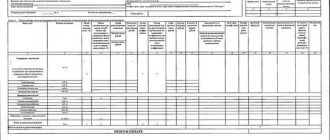Payment IDs
Let's figure out what this new form of payment document looks like in 2021. Everyone pays housing and communal services, so the information will be useful to every resident.
Officials have made a lot of changes to the utility bills, but the main thing is the appearance in it of two new fields for identifiers generated in the Housing and Communal Services GIS:
- one identifies a specific payment document;
- the second is a single personal account of the payer.
Let us remind you that the GIS housing and communal services system is a unified information system, which necessarily includes all suppliers of utilities and related services and all organizations that service apartment buildings (management companies, HOAs). It contains information about objects, services, tariffs and other important information. Homeowners have the right to connect to the system, control payments in it, services received, and even make payments.
In fact, a paper receipt for housing and communal services duplicates the payment information generated in the GIS housing and communal services for the corresponding month. Thanks to the appearance of identifiers in payment slips, data on payments made through a bank using a paper payment slip are automatically included in the GIS.
What does a sample rent receipt look like in 2021?
On the timing and procedure for the consumer to take readings of individual, common (apartment), room metering devices and transfer information about the readings to the contractor or his authorized person in the cases and procedure established by the Rules for the provision of utility services to owners and users of premises in apartment buildings and residential buildings, approved by the resolution Government of the Russian Federation dated May 6, 2021 No. 354 (Collected Legislation of the Russian Federation, 2021, No. 22, Art. 3168; 2021, No. 23, Art. 3008; No. 36, Art. 4908; 2021, No. 16, Art. 1972 ; No. 21, Art. 2648; No. 31, Art. 4216; No. 39, Art. 4979; 2021, No. 8, Art. 811; No. 9, Art. 919; No. 14, Art. 1627; No. 40, Art. 5482; No. 47, Art. 6550, No. 52, Art. 7773; 2021, No. 9, Art. 1316; No. 37, Art. 5153; 2021, No. 1, Art. 244; No. 27, Art. 4501; 2021, No. 2, Art. 338, No. 11, Art. 1557; No. 27, Art. 4052; No. 38, Art. 5628).
The rows in the table can be supplemented with other names of services. It all depends on the specific organization that services the house (management company, HOA, etc.). If this is regulated by regional acts and the consent of the residents is obtained.
Often in the receipt there is a column - installation of UUTE or ODPU , which stands for installation of a heat energy metering unit and installation of common house metering devices, while it should be remembered that the installation of meters is an obligation, not a desire of the residents, as well as reimbursement of the costs of their installation.
If the column contains the wording “locking device,” this could be payment for an intercom device, an automatic locking device with an electromagnetic lock, or a mechanical combination lock.
There are several aspects to consider when answering this question. Thus, according to the law, in an apartment building, receipts for payment of utility services are sent and generated by management organizations. They are authorized to calculate the consumption of the following housing and communal services:
- for water supply;
- per apartment (depending on the number of persons registered there);
- for major repairs, etc.
Citizens receive separate receipts for gas and electricity supplies. This is due to the fact that these organizations are direct suppliers of utility services, and therefore charge directly.
Before you understand the difference between these concepts, you need to understand the meaning of this abbreviation.
Housing and communal services is understood as housing and communal services as a branch of the economy engaged in the study and formation of a range of services necessary for the normal life support of the population.
Housing and communal services are housing and communal services, that is, a specific resource provided to citizens - electricity, hot water, etc.
The concept of housing and communal services is much broader than the concept of housing and communal services, and includes, in addition to the list of services, other essential provisions, legal norms, standards, etc.
Depending on the basis on which a citizen owns housing, the receipt may include various elements. This includes rent, capital and current repairs, housing and communal services, etc.
It is also important to determine the basis on which the total amount payable is formed. First of all, the formation of payments is influenced by contracts concluded by citizens and government organizations (for example, a social rental agreement). Particular attention should be paid to regulations adopted in the region on the provision of utility services. You also need to take into account the tariffs in force in the constituent entity of the Russian Federation. The readings of meters installed in citizens’ apartments are also very important.
New housing and communal services receipt form: composition
In addition to the appearance of GIS housing and communal services identifiers, the payment system now contains more information for payers. That is for us. Now the payment document for housing and communal services in 2021 consists of six sections:
- Data of the payer and service provider.
- Data on the readings of individual metering devices (meters).
- Calculation of the amount of payment for the maintenance of residential premises and utilities.
- Reference Information.
- Calculation of the amount to be paid taking into account installments.
- Data on the payer’s recalculations (additional accrual +, reduction -).
Thus, right in the receipt itself, the owner or tenant of the apartment will be able to see all the information about the payments made to him for the maintenance of common property for each type of resource, the tariff and the volume of his consumption of various resources for the month. The receipt also contains information about the balance, fines and penalties. It is noteworthy that there is more information, but, on the contrary, there are fewer sections. In the previous version there were eight of them.
New law on the Unified Receipt for Housing and Communal Services 2019-2020 (what is the essence): latest news
Instead of separate receipts for water, gas and other utilities, homeowners will receive a single payment. For this purpose, the State Duma of the Federal Assembly of the Russian Federation in November 2021 prepared a new version of amendments to the Housing Code. The bill on a single receipt, which will indicate all housing and utility payments, should be adopted by the lower house of the Russian parliament in the autumn session of 2021 or the spring session of 2021 with appropriate changes to the current law. The new law from 2021 will help solve the problem of debt of owners and, possibly, will allow for a slight reduction in tariffs. One of the authors of the initiative, First Deputy Chairman of the State Duma Committee of the Federal Assembly of the Russian Federation on housing policy and housing and communal services, Sergei Pakhomov, told a TASS correspondent about this.
Pakhomov explained that this “bill eliminates the current practice in certain regions, and there are many of them, where every month each resource supplying organization sends people its own separate receipt, and as a result, consumers accumulate several payment documents in which they get confused.” “These are both small regions, like Ulyanovsk, and large republics, for example Bashkiria,” he added. The bill provides for the introduction of such a type of receipt as a single payment document (UPD), “which will detail in detail what, to whom and how much a citizen owes, so that he can decide on the spot what to pay for and what not to.” “This option is also provided - a citizen can cross out something if he does not agree with something. And the EPD itself should also improve payment discipline and allow reducing costs with the issuance of receipts and invoices by different organizations,” Pakhomov continued. The bill, according to the text, does not provide for the mandatory replacement of individual receipts with EPD. The deputy explained that now every resource supplying organization has a staff of employees “who calculate all this, print it all out, and send it out.” The draft law provides for the involvement of settlement centers for this purpose, to which providers of housing and communal services (HCS) will send data. “Today there is already a system of unified settlement centers that issue a single payment document; each region determines for itself how to do this. In some regions there are several such centers, but there are no regions where they do not exist.
Somewhere these are private organizations, somewhere municipal, and somewhere it’s a single regional settlement center that only collects all the information and prints a payment document,” the parliamentarian noted. Tariffs for housing and communal services will not increase. According to Pakhomov, the use of this mechanism cannot in any way lead to an increase in the cost of services, since resource supplying organizations are already spending money on processing data and sending out receipts, which, on the basis of contracts, will be done by settlement services, the deputy assured, clarifying that “there is such an option, but in no case should the costs increase.” Electronic receipts The bill, among other things, provides for the distribution of an electronic version of the EPD, but, as the agency’s interlocutor stated, it is too early to talk about a complete abandonment of paper “payments”, since the necessary information system, which is currently functioning only in test mode, must be operational. “This is the future in any case,” summed up Pakhomov. The authors of the bill indicate that up to 60% of requests to housing inspectors are related to charges for services that are incorrect or incomprehensible to citizens. Data in payment bills from different suppliers of utility resources often differ - the area of the apartments, the number of residents, etc. differ. In the Lipetsk, Samara and Tula regions, in the Crimea and Khakassia, debts for housing and communal services are growing due to the fact that the population, confused in payment bills, which sometimes a dozen come and refuse to pay for them. At the same time, the cost of issuing and delivering each invoice is estimated at 16-23 rubles. And scammers are taking advantage of the confusion, sending out fake bills in the hope that residents will pay them too. In this regard, deputies initially proposed to legislate the possibility of using a “single payment document” - to indicate in one receipt all or at least some types of utilities, fees for maintenance and repairs, fees for major repairs, for renting housing, etc. In addition, the bill allowed management organizations to engage settlement centers to calculate payments and provide payment documents. It was assumed that the services of the settlement center would be paid for by organizations that pay for housing and utilities. The government, however, gave a negative review of the project, since the document did not contain clear criteria for “unified payment documents” that distinguish them from those already specified in the Housing Code of the Russian Federation, and the procedure for creating settlement centers was not specified. In addition, the provision on payment for the services of the centers, as indicated in the government review, may lead to an increase in the amount of fees for housing and communal services. The Duma Committee on Housing Policy and Housing and Communal Services also demanded that the project be reworked. At the beginning of November 2021, the relevant Duma committee discussed the second, revised version of the document, which will soon be sent to government agencies and regions to receive feedback. Its essence remains the same, but in the new edition the terms “single payment document” and “settlement center” are no longer mentioned. “The term “single payment document” in the bill could be read incorrectly - as “the same” for everyone, as the introduction of a uniform form of receipt in the region,” explains Dmitry Gordeev, deputy general director of the Housing and Communal Services and Urban Environment Association. The costs associated with printing and delivery of payment slips by third-party organizations, according to the new edition, will be taken into account when establishing state-regulated tariffs for utility resources. “Now almost every service provider has a subscriber department that processes payments and issues receipts. But now the costs of this will be taken into account in the tariffs for all utilities! - emphasizes Gordeev. “One might even think that if multiple suppliers were to issue a common billing document, such costs would be reduced.” According to Gordeev, the bill is of a clarifying nature. Organizations can still issue general payments now, but if the amendments are adopted, this will be more clearly spelled out in the Housing Code. However, this form of receipt will not become mandatory. Resource supply organizations and management companies will decide independently whether to “unite” in one bill, Rossiyskaya Gazeta reports. In total, in 2021, these changes will affect residents of all regions of Russia Adygea, Altai, Bashkiria, Buryatia, Dagestan, Ingushetia, Kabardino-Balkaria, Kalmykia, Karachay-Cherkess Republic, Karelia, KOMI, Crimea, Mari El, Mordovia, Sakha (Yakutia), North Ossetia (Alania) ), Tatarstan, TUVA, Udmurtia, Khakassia, Chechnya, Chuvashia, Altai Territory, Transbaikal Territory, Kamchatka Territory, Krasnodar Territory, Krasnoyarsk Territory, Perm Territory, Perm Territory, Primorsky Territory, Stavropol Territory, Khabarovsk Territory, Amur Region, Astrakhan Region, Arkhangelsk region, Belgorod region, Bryansk region, Vladimir region, Volgograd region, Vologda region, Voronezh region, Ivanovo region, Irkutsk region, Kaliningrad region, Kaluga region, Kemerovo region, Kirov region, Kostroma region, Kurgan region, Kursk region, Leningrad region , Lipetsk region, Magadan region, Moscow region, Murmansk region, Nizhny Novgorod region, Novgorod region, Novosibirsk region, Omsk region, Orenburg region, Oryol region, Penza region, Pskov region, Rostov region, Ryazan region, Samara region, Saratov region, Sakhalin region region, Sverdlovsk region, Smolensk region, Tambov region, Tver region, Tomsk region, Tula region, Tyumen region, Ulyanovsk region, Chelyabinsk region, Yaroslavl region, federal cities - Moscow, St. Petersburg, Sevastopol, Jewish Autonomous Okrug, Khanty-Mansi Autonomous Okrug, Yamal-Nenets Autonomous Okrug , Nenets and Chukotka Autonomous Okrug.
30.07.2019 16:07
What's not on the updated receipt?
Officials removed all data on major repairs from the updated form. Now we pay for it on a separate receipt. Therefore, the following sections have been removed from the payment plan:
- 7. “Calculation of the amount of contribution for major repairs”;
- 8. “Information for making a contribution for major repairs.”
So, the once single payment document for housing and communal services is now divided into several receipts.
Also, advertising will no longer be placed on payment documents for housing and communal services. This is determined by amendments to the Housing Code of the Russian Federation, which came into force at the end of April last year. Now (in 2021) only socially significant and reference information for citizens is allowed to be placed on forms. In addition, there is practically no space left on the form for this.
What does the new housing and communal services payment form look like?
The receipt for payment of housing and communal services has become two-sided. The first sheet contains sections from the first to the third (the most voluminous of all), and the second contains all the other sections.
Sample receipt for payment of utilities in 2021, front side
Receipt form for payment for housing and communal services 2021, reverse side:
Please note that two identifiers are located at the very beginning of the form. This is how a sample housing and communal services receipt for 2021 begins (compiled by the editors of the Sashka Bukashka website):
Also remember that the form approved by the order of the Ministry of Construction of Russia is not mandatory, but recommended or “exemplary,” as stated in the order itself. And each management organization or HOA has the right and opportunity to transform the form of the payment document to suit its own needs. The main thing is that any form developed independently by the service provider must retain information about identifiers in the GIS housing and communal services system. Using them, the tenant has the opportunity to check the correctness of all charges made and the accounting of the payment made by him.
About the author of the article
Yulia Didukh Accountant, commercial lawyer, editor-in-chief of the channels “Legal Council”, “Veteran of Labor” and “Man in Uniforms at School” on the Yandex platform. Zen
New housing and communal services tariffs
The Ministry of Construction wants Russians to be able to choose the most convenient tariff for themselves when paying for housing and communal services. Officials have developed tariff plans that will depend on several variables: time of consumption, its volume, as well as methods and terms of payment. In particular, officials intend to divide services into the following three packages:
- “Economy”, in which a minimum price will be set with a clear list of conditions. The tariff will include a fixed volume of consumption and a certain payment system (prepayment). The tariff will not provide additional services for users.
- “Standard” will include payment for utilities at a tariff in accordance with actual consumption. In this case, users will receive a standard set of services.
- “All inclusive” will include a fixed monthly payment, which will not depend on the actual volume of consumption. In addition, the user will receive an additional set of services. Officials have not yet announced what services these will be; their list is still under development.
The Ministry of Construction does not announce the timing of the introduction of new tariff plans for housing and communal services. The Ministry of Construction also has not yet reported how service providers and management organizations will cover funds for exceeding fixed consumption volumes. Experts are skeptical about the idea and give conflicting comments. PPT.ru will continue to monitor developments.











